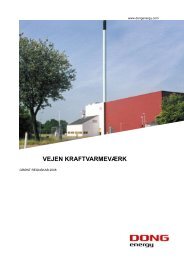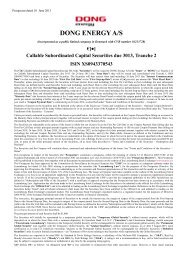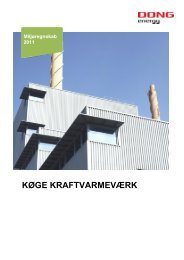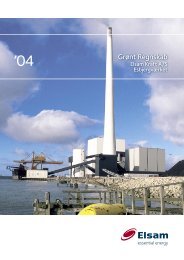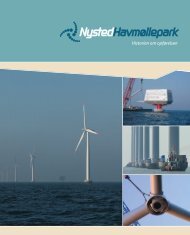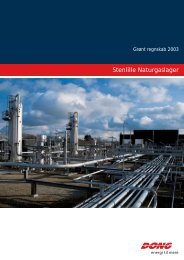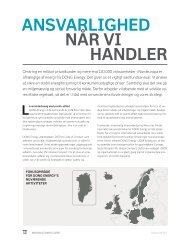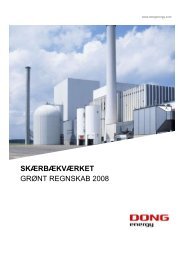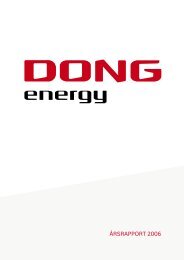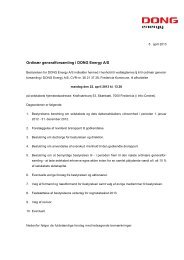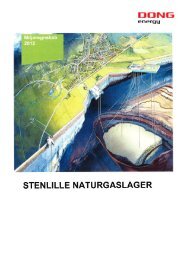ANNUAL REPORT 2011 - DONG Energy
ANNUAL REPORT 2011 - DONG Energy
ANNUAL REPORT 2011 - DONG Energy
Create successful ePaper yourself
Turn your PDF publications into a flip-book with our unique Google optimized e-Paper software.
glossaRy<br />
relatively low (off-peak). The contribution margin is also affected<br />
by the fact that the cost of coal for accounting purposes<br />
differs from the market price resulting from application<br />
of the FIFO (first-in, first-out) principle to inventories.<br />
In addition, <strong>DONG</strong> <strong>Energy</strong> is allocated a specific volume of<br />
CO emissions allowances.<br />
2<br />
Green spark spread (Gss): Green spark spread represents<br />
the contribution margin per MWh generated at a gas-fired<br />
power station of a given efficiency. It is measured as the<br />
difference between the market price of electricity and the<br />
costs of gas and CO allowances used for generating the<br />
2<br />
electricity.<br />
Hydrological balance: Most of the electricity generated in<br />
the Nordic countries comes from hydro electric stations,<br />
and their output depends on their water reservoir levels.<br />
The hydrological balance reflects whether the level in the<br />
Norwegian and Swedish water and snow reservoirs is<br />
above or below normal.<br />
isDa: The International Swaps and Derivatives Association.<br />
Develops standard contract documentation that can<br />
be used for mutual trading in derivative financial instruments.<br />
lEBa: London <strong>Energy</strong> Brokers’ Association.<br />
lnG: Liquefied Natural Gas. Gas that has been liquefied by<br />
cooling to minus 161 degrees Celsius. LNG takes up 600<br />
times less space than conventional gas. LNG can be transported<br />
in customised tankers, enabling it to be transported<br />
from remote destinations. In the receiving terminal, the<br />
LNG is vaporised and pressurised before being routed into<br />
the transmission system for onwards distribution and sale.<br />
ltif: Lost Time Injury Frequency. <strong>DONG</strong> <strong>Energy</strong> defines<br />
lost time injuries as occupational injuries resulting in at<br />
least one day’s absence from work in addition to the day of<br />
the injury.<br />
mifiD: Markets in Financial Instruments Directive. EU Directive<br />
designed to harmonise the European Union’s financial<br />
markets and increase cross-border investments.<br />
million boe: Million barrels of oil equivalent.<br />
nBp: National Balancing Points, UK gas hub.<br />
nord pool: The Norwegian-based Nordic power exchange,<br />
which facilitates electricity trading in Norway, Sweden, Finland<br />
and Denmark.<br />
nO x : Nitrogen oxides.<br />
Operator: The company appointed to conduct operations<br />
under an exploration, production and/or development licence<br />
or concession governing an oil or gas licence or concession<br />
area.<br />
peak and off-peak: Reflects prices for electricity generated<br />
at times during the 24-hour cycle with high demand and<br />
low demand respectively.<br />
pJ: Petajoule, a unit of energy. 1 PJ is equivalent to 1,000 TJ<br />
or 1,000,000 GJ or 1,000,000,000 MJ.<br />
rEmit: Regulation on <strong>Energy</strong> Markets Integrity and Transparency.<br />
EU Regulation on integrity and transparency in<br />
energy markets to prevent insider dealing and market manipulation.<br />
sO 2 : Sulphur dioxide.<br />
spE-prms Guidelines: Internationally accepted guidelines<br />
for the evaluation of gas and oil reserves prepared by<br />
Society of Petroleum Engineers (SPE).<br />
supply obligation: A company with a supply obligation is<br />
bound by law to deliver electricity or gas to a certain geographic<br />
area at prices approved by the Danish <strong>Energy</strong><br />
Regulatory Authority.<br />
thermal generation: Electricity and heat generated<br />
through the combustion of fossil fuels, biomass or waste.<br />
time lag: Oil price changes and changes in the USD exchange<br />
rate impact on gas sales prices relatively quickly,<br />
whereas purchase prices are adjusted with a time lag effect<br />
of up to a year and a half. For example, a change in the<br />
price of oil and/or the USD exchange rate in January may<br />
affect <strong>DONG</strong> <strong>Energy</strong>’s sales prices already in February, but<br />
may not be felt on purchase prices before the summer of<br />
the following year. The impact on the individual periods<br />
consequently varies, and this may lead to considerable<br />
fluctuations in operating profit from one period to the next<br />
in the case of oil price changes. However, the fluctuations<br />
will balance each other out over a number of years.<br />
ttf: Title Transfer Facility, Dutch gas hub.<br />
twh: Terawatt hour. The amount of energy generated in<br />
one hour with the effect of 1 TW. 1 TWh is equivalent to<br />
1,000 GWh or 1,000,000 MWh.<br />
value at risk (var): Indicator that reflects the maximum<br />
amount by which the value of a position will fall in the<br />
course of one day, with a probability of 95%, given normal<br />
market conditions.<br />
wood pellets: Wood that has been pulverised and pelletised<br />
under heat and high pressure.<br />
128 aDDitiOnal infOrmatiOn – <strong>DONG</strong> ENERGY GROUP <strong>DONG</strong> <strong>ANNUAL</strong> ENERGY <strong>REPORT</strong> <strong>ANNUAL</strong> <strong>2011</strong> <strong>REPORT</strong> <strong>2011</strong> – aDDitiOnal infOrmatiOn<br />
189<br />
glossaRy<br />
128



